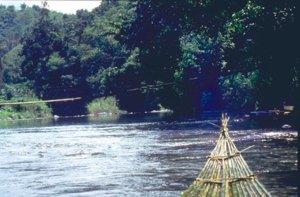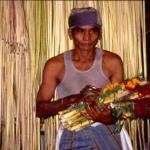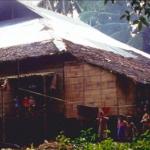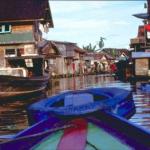South Kalimantan: The Land of a Thousand Rivers
My last thought before sleep was that the calling-drum suspended from the rafters would fall on my head. My concern was best explained by the suggestive powers of my location: the floor of a Dayak longhouse, a people who used to decapitate their enemies.
The Orang Bukit were banging on the drum in rhythmic beats when I struggled out of the forest with Rayhan, my guide. In the past, the drum would have warned of our approach as a party of potential headhunters. Today it was in celebration of a bountiful rice harvest. Although I was tired, muddy and smelled like a locker room, protocol demanded that I enter the longhouse, accept refreshment and commune with the dead.
The ancestors needed to be thanked. Men danced to the hypnotic beat of the drum around a palm leaf altar erected in the middle of the longhouse. Women who wanted to contact the departed, either in gratitude or supplication, sat with fresh flowers on their heads. The headman fell to the floor, his limbs twitching in trance. His wife bent over him and deciphered the mumbling messages he relayed from the afterlife. It was an extraordinary experience suddenly made ordinary when the headman, his duties as medium complete, rose from the floor and lit a cigarette. In Indonesia, the natural and supernatural are not static and distinct conditions; each exists within the other. The longhouse population renewed their seance later that night; in the meantime, watching their guest clumsily bathe in the river proved temporarily more interesting.
The fuzzy separation between altered states was important to me. Witnessing the festival was simply fortunate circumstance. A contrived event would be a disappointment after walking four hours through secondary tropical forest to get there. The Orang Bukit Dayaks of the Loksado area of South Borneo no longer wear loincloths and bird feathers; their bodies are not decorated with protective tattoos and heavy ornaments do not stretch their earlobes. Betel nut chewing has fallen out of favor with the youth because they prefer white teeth to red ones. If a visitor leaves behind his misguided prejudice for the "primitive", then what remains unchanged to experience is a form of social organization favored by the Dayaks: cooperative housing with its cultural values of compromise and tolerance.
I had less to worry about a falling drum than making a spectacle of myself. The women and children of the longhouse talked long into the night about me, squatting by my dozing form. I woke to their scrutiny. They accompanied me en masse on my morning ablutions. I found their proximity uncomfortable. In a longhouse of fifteen or more families, however, privacy cannot exist. Intense curiosity is acceptable conduct.
The headman had married a young couple that morning. I couldn't help considering the practicalities of a wedding night: the consummation would take place on the floor, beside family and friends, possibly next to me. (I never heard them.) A handsome young man sought advice from the guide: his thirteen-year-old wife rejected his attempts at intimacy. An old woman's husband of many years had left her for an older and fatter woman. Such candid interactions are only possible between people who know everything about each other. If there are no secrets in the longhouse and no skeletons in the closets (apart from a few heads), then it is conceivable that harmony prevails.
The Dayak tribes, which number over two hundred, are the indigenous peoples of Borneo. Formerly hunters and gatherers, they lived in isolated longhouses in the once vast forests now diminished by logging. Both the location of their communities and their form of cohabitation protected them from their enemies. Now many Dayaks live in cities, their lives no different from their Indonesian neighbors. Those choosing to live traditionally, such as the Orang Bukit, practice slash-and-burn dry rice agriculture. They also produce rubber and cinnamon that they sell at the Loksado Village market twice a week. None of the Orang Bukit I spoke with had ever been to Banjarmasin, the capital of South Borneo and the largest city in Kalimantan.
This still counts as living in isolation to me. So does the fact that going to the market, to the health clinic and to the school mean a several hour walk on wet, undulating trails. Mosquitoes are voracious. I lost count of the swiftly moving streams I had to cross; the spills I took in the mud. The heat of the rain forest is heavy, like a weight upon the body. It is no place for vanity. The Orang Bukit make their environment look more benign than it is. In this, they are guided by their faith.
The Dayaks' earliest beliefs were and continue to be a form of animism known as Kaharingan. It recognizes a principal creator of their universe but many lesser gods also exist in the cosmology. Karmic laws of cause and effect are upheld by supernatural beings that must be kept appeased through regular ritual. Favorable weather for crops and successful agricultural cycles are influenced by conduct. Misfortune can be explained and rectified by ceremony. The women of the Orang Bukit boiled a special food of ground rice, coconut, sugar and lime which was offered one night to "The Great One" for his benevolence throughout the year. Prayers in the form of prolonged chanting lulled me to sleep, not my curative of choice for the hard bamboo floor, but an effective one.
Courtesy, generosity and honesty are valued social behaviors of the longhouse and manifestations of Kaharingan belief that fortuitous life events result from actions of the entire social unit. Without such faith, the mutual respect that is required by multiple family living would be a difficult achievement. The headman of the longhouse ensures that these qualities are upheld. The small gifts that I had brought were presented formally to the headman only after a suitable length of time. It seemed important that I was the recipient of Dayak hospitality before giving in return. The headman was careful to express his appreciation several times. Although my belongings generated a high level of interest, I was not requested to part with anything other than Band-Aids and aspirin.
Religion cannot be separated from culture. The powerful forces of nature in the Dayaks' visible world'the violent storms, the raging rivers, and the mysterious jungle'are what shape their beliefs. They know these same phenomena can take away life as well as they help sustain it. Their views reflect the experience that death can be sudden. The women pointed out their young who bore the marks of a serious illness, amulet necklaces of string given to them by the headman in his secondary role as shaman. The people suffer from infections, injuries, respiratory ailments and malaria. Many of the Orang Bukit described severe headaches that were more prevalent during the harvest when the workload is greatest.
Perhaps any culture that faces death as frequently as the Dayaks ends up embracing it. It is not something the Dayaks fear. Its passage, particularly in the past, was marked with elaborate rituals. Severed human heads were not gruesome trophies of unjustified aggression but talismans necessary to perpetuate life. Death was a magical state that ended with life, and not the reverse.
Because life and death are parallel realities and life within death can take human or animal form and ghosts travel between the two worlds. Not surprisingly, the jungle, with its incessant noises from invisible insects and wildlife, is considered a likely place to meet them. On one of my walks with a Dayak guide in primary forest, an animal, unseen but threatening, warned of encroachment upon its territory. I feared something I had seen behind bars in a zoo. The guide, however, imagined an impermanent creature: "Ghosts," he said, "are never friendly."
The Dayaks believed that the Land of the Dead was at the end of a river and they set the dead adrift in carved coffins. River motifs appear on Dayak baskets and weavings. It is easy to see why the waterways play such a pivotal role in Dayak life and death. If you look at a map of the island, a spider web of rivers and their tributaries covers its entire surface. Each longhouse I visited was situated by a river, which fit my image of a lost paradise. All were scenes of constant activity. The river was a food source and a supply of drinking water. It was where rice was rinsed, clothes and dishes washed and bodies cleansed. I sat by a river one entire afternoon, amidst clouds of butterflies with glossy wings, and saw that its uses were not merely physical. The river was a playground for children, a recreational center for teenagers and a community center for adults; it was where social skills were learned, where people fell in love, where decisions were made.
In Borneo, the main street of town is usually a river. Boats are the chief form of transportation to most destinations. On my return to Banjarmasin from Loksado, I eliminated hours of tiresome hiking and the emotional trauma of leeches by rafting down the Riam Kiwa River on 16 stems of young bamboo lashed together to form an apex at the front. My raft served another purpose: upon arrival in Kandangan, it was dismantled and the bamboo sold. My raftsman was so experienced at running rapids that the ubiquitous Indonesian cigarette was never dislodged from between his lips. I sat with legs on either side of a narrow, raised platform of bamboo, with my feet ankle-deep in water and my camera in a plastic bag. It was not comfortable but neither is bus travel on Kalimantan roads and the rapids were far more fun.
The city of Banjarmasin was where I had arranged my trek. The Loksado Dayak tribes may be the descendants of the founding families of this city, who moved to the Meracus Mountains to avoid conversion to Islam in the fifteenth century. The Banjarese capital started as a settlement of wooden houses on stilts along the banks of the converging Barito and Martapura Rivers, for like the Dayak tribes, proximity to the river was tantamount to survival.
"The real Banjarmasin can only be seen from the river," I was told. The city's many canals have earned it the name "Venice of the East," a comparison it shares with Bangkok. I hired a boat late one afternoon when the day's heat had dissipated, the light was kindest for photography and the riverside activities were liveliest.
On extended platforms behind ironwood houses, generations of Banjarese congregated along the canals for a bath in cleaner waters brought in by the tide, a practical consideration now due to river pollution. However, this was a ritual of a people whose symbiotic relationship with the river mirrors that of the Loksado Dayaks. It was as much about community as it was about cleanliness. This gathering was a daily festival on Banjarmasin's canals, a celebration of the day's closure and the simple pleasures of water, family and friends. My intrusion of the party was welcomed. Rarely do I find the voyeurism of travel so enjoyable.
I had breakfast at the more famous of Banjarmasin's two floating markets, known as pasar terapung; where buyers and sellers of produce and household necessities do business from canoes every morning. Tourism has replaced the trading practices of Bangkok's floating markets by becoming a lucrative commodity itself I saw no such negative impact here. My presence was politely ignored.
My boat was temporarily moored to a bobbing tea and cake shop: customers helped themselves to pastries in shallow dishes by spearing them with a nail on a long wooden stick. The cheerful proprietor rinsed his glasses in river water that was the color of his coffee but the historical value of a meal on the river was more important than the less than pristine water quality. For four hundred years, traders such as he have gathered at the confluence of the Barito and Kuin Rivers, shielded from the extremes of weather by a straw hat as large as an expanded umbrella.
The significant difference to this recognizable picture of Banjarmasin's past is the large vessels of a modem seaport carrying cargo such as rattan and lumber, two of the city's principal export industries. Few visitors are unaware of deforestation issues today in Indonesia and elsewhere in the world. The open mind I intended to keep slammed shut in a hurry when I saw the barges in the river piled with hardwood logs. I was saddened: once the rivers had protected the inaccessible rainforest and the people it sustained; now they enabled its destruction and enforced another way of life.
There are as many versions of reality as there are people and cultures; travel sometimes allows you to share the perspectives of others. However brief the encounter, it brings irreversible changes to those involved. It is not so simple to ascertain what you leave behind in these chance meetings; it is far easier to recognize what you have gained. My river travels through South Kalimantan revealed a worldview that was instinctive. It had to be: nature plays a large role in the lives of people who live by and depend upon a river, or for those who live in the rainforest. I had forgotten that once we all lived intuitively with the natural forces of our world.
In Kalimantan, I remembered.
Author's Note:
Kalimantan is the Indonesian southern half of Borneo and is divided into four provinces. The original settlement of Banjarmasin, the capital of Kalimantan, was built over water which has led to its comparison with Bangkok. A canal trip on its backwaters and a visit to its floating markets are highly recommended. Banjarmasin is the departure point for trips into its mountainous interior, where Dayaks called the Orang Bukit live.
Getting There:
Garuda, Indonesia's national carrier, flies several times daily to Banjarmasin from Jakarta on the island of Java.
When to Visit:
Avoid the rainy season between November and March. Besides the downpours, there will be additional leeches in the forests with which to contend.
Trekking:
Johan, the owner of the Borneo Homestay, arranges tours to the Loksado region. Everyone in Banjarmasin knows of him. A friendly travel agency is centrally located Adi Travel on Jalan Hasanuddin 27.
 ThingsAsian
ThingsAsian



















